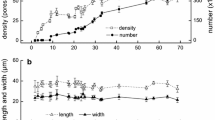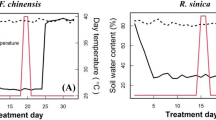Abstract
The responses of leaf conductance, leaf water potential and rates of transpiration and net photosynthesis at different vapour pressure deficits ranging from 10 to 30 Pa kPa-1 were followed in the sclerophyllous woody shrub Nerium oleander L. as the extractable soil water content decreased. When the vapour pressure deficit around a plant was kept constant at 25 Pa kPa-1 as the soil water content decreased, the leaf conductance and transpiration rate showed a marked closing response to leaf water potential at-1.1 to-1.2 MPa, whereas when the vapour pressure deficit around the plant was kept constant at 10 Pa kPa-1, leaf conductance decreased almost linearly from-0.4 to-1.1 MPa. Increasing the vapour pressure deficit from 10 to 30 Pa kPa-1 in 5 Pa kPa-1 steps, decreased leaf conductance at all exchangeable soil water contents. Changing the leaf water potential in a single leaf by exposing the remainder of the plant to a high rate of transpiration decreased the water potential of that leaf, but did not influence leaf conductance when the soil water content was high. As the soil water content was decreased, leaf conductances and photosynthetic rates were higher at equal levels of water potential when the decrease in potential was caused by short-term increases in transpiration than when the potential was decreased by soil drying.
As the soil dried and the stomata closed, the rate of photosynthesis decreased with a decrease in the internal carbon dioxide partial pressure, but neither the net photosynthetic rate nor the internal CO2 partial pressure were affected by low water potentials resulting from short-term increases in the rate of transpiration. Leaf conductance, transpiration rate and net photosynthetic rate showed no unique relationship to leaf water potential, but in all experiments the leaf gas exchange decreased when about one half of the extractable soil water had been utilized. We conclude that soil water status rather than leaf water status controls leaf gas exchange in N. oleander.
Similar content being viewed by others
References
Bates LM, Hall AE (1981) Stomatal closure with soil water depletion not associated with changes in bulk leaf water status. Oecologia (Berlin) 50:62–65
Björkman O, Downton WJS, Mooney HA (1980) Response and adaptation to water stress in Nerium oleander. Carnegie Inst Wash Yearbook 79:150–157
Boyer JS, Knipling EB (1965) Isopiestic technique for measuring leaf water potentials with a thermcouple psychrometer. Proc Nat Acad Sci US 54:1044–1051
Camacho-B SE, Hall AE, Kaufmann MR (1974) Efficiency and regulation of water transport in some woody and herbaceous species. Plant Physiol 54:169–172
Cowan IR (1977) Stomatal behaviour and environment. Adv Bot Res 4:117–228
Denmead OT, Shaw RH (1962) Availability of soil water to plants as affected by soil moisture content and meterological conditions. Agron J 54:385–390
Martin EV (1940) Effect of soil moisture on growth and transpiration in Helianthus annuus. Plant Physiol 15:449–466
Ritchie JT (1974) Atmospheric and soil water influences on the plant water balance. Agric Meteorol 14:183–198
Schulze E-D, Küppers M (1979) Short-term and long-term effects of plant water deficits on stomatal response to humidity in Corylus avellana L. Planta 146:319–326
Seaton KA, Landsberg JJ, Sedgley RH (1977) Transpiration and leaf water potentials of wheat in relation to changing soil water potential. Aust J Agric Res 28:355–367
Thornthwaite CW, Mather JR (1955) The water budget and its use in irrigation. U.S. Dept Agr Yearbook of Agriculture 1955:346–358
Turner NC, Schulze E-D, Golland T (1984a) The responses of stomata and leaf gas exchange to vapour pressure deficits and soil water content. I. Species comparisons at high soil water contents. Oecologia (Berlin) 63:338–342
Turner NC, Spurway RA, Schulze E-D (1984b) Comparison of water potentials measured by in situ psychrometry and pressure chamber in morphologically different species. Plant Physiol 74:316–319
Turner NC, Schulze E-D, Gollan T (1985) The responses of stomata and leaf gas exchange to vapour pressure deficits and soil water content. II. In the mesophytic herbaceous species Helianthus annuus. Oecologia (Berlin) 65:348–355
Veihmeyer FJ (1956) Soil moisture. In: Encyclopedia of Plant Physiology. III. Water Relations of Plants. Springer, Berlin, pp 64–123
Veihmeyer FJ, Hendrickson AH (1950) Soil moisture in relation to plant growth. Ann Rev Plant Physiol 1:285–304
Author information
Authors and Affiliations
Rights and permissions
About this article
Cite this article
Gollan, T., Turner, N.C. & Schulze, E.D. The responses of stomata and leaf gas exchange to vapour pressure deficits and soil water content. Oecologia 65, 356–362 (1985). https://doi.org/10.1007/BF00378909
Received:
Issue Date:
DOI: https://doi.org/10.1007/BF00378909




